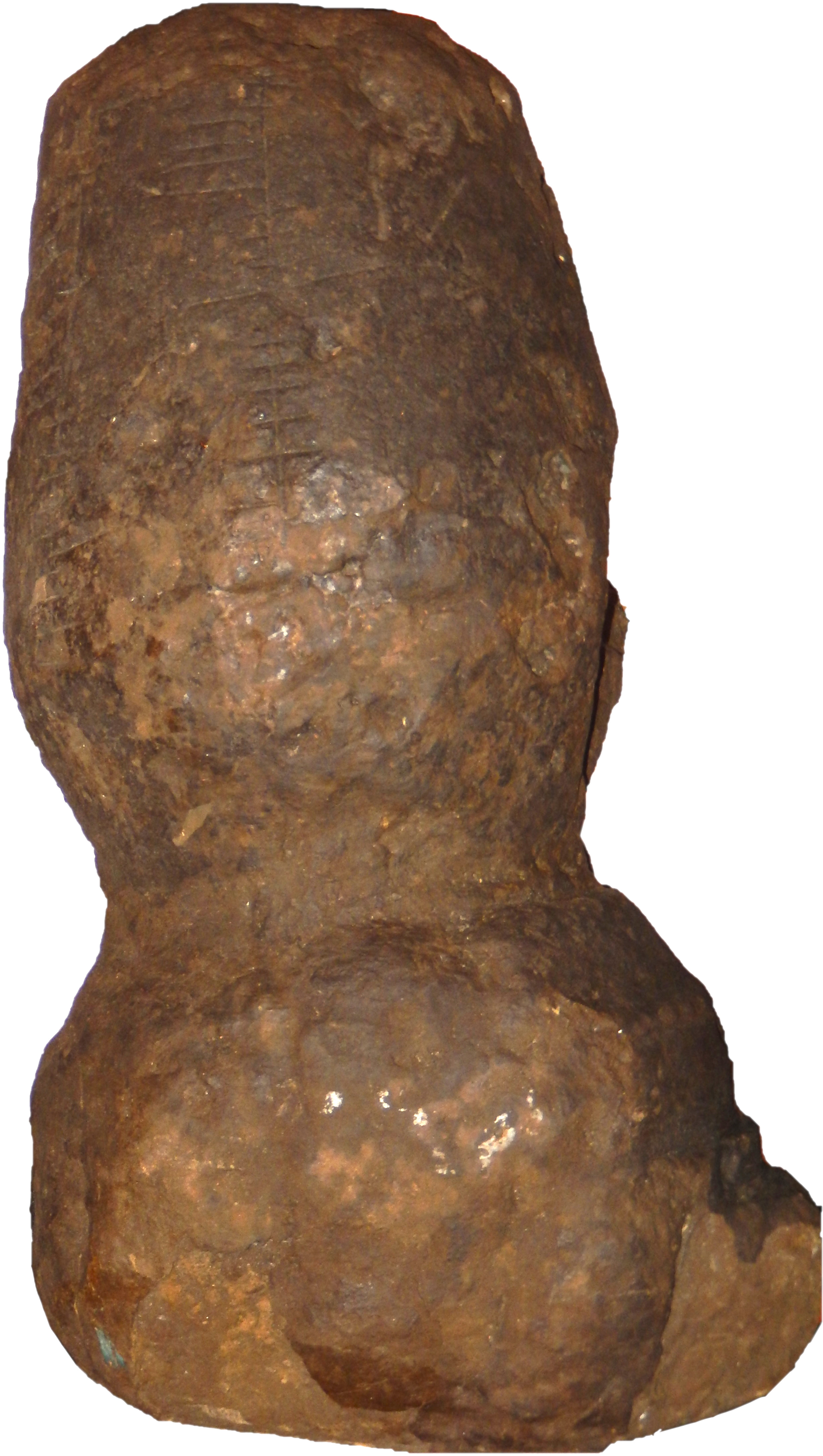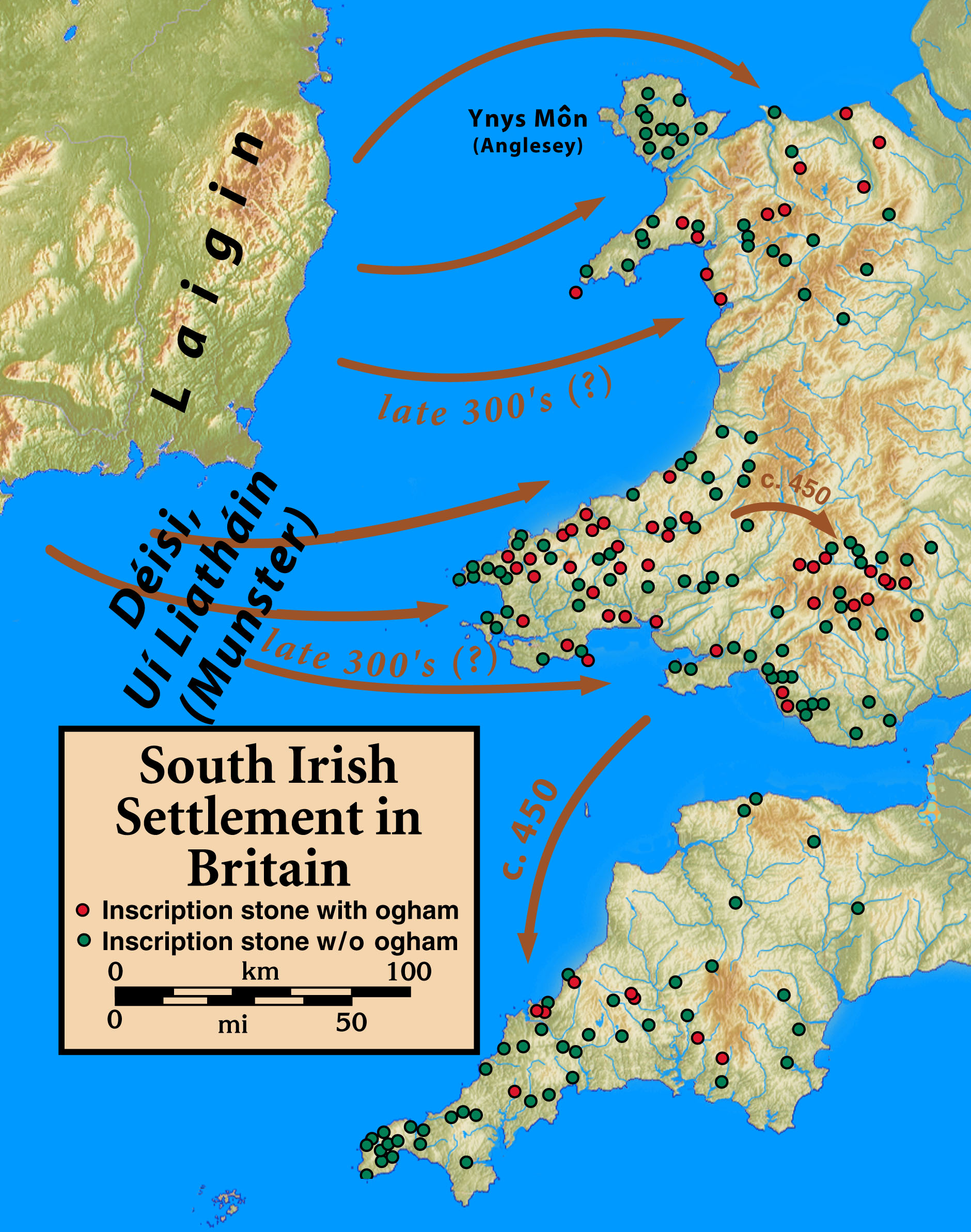Silchester Ogham Stone on:
[Wikipedia]
[Google]
[Amazon]
 The Silchester Ogham stone is a pillar stone discovered at the Roman town on
The Silchester Ogham stone is a pillar stone discovered at the Roman town on
 The pewter vessel, when reconstructed, turned out to be "a simple, biconical flagon similar to a few other examples found in southern Britain which can be dated broadly to the fourth and no earlier than the late third century." The most recent version of the translation on the stone is " he somethingof Tebicatus, son of the tribe of N”. The missing word may be "memorial" or, less probably, "land", if the stone were a territorial marker rather than a grave marker. J. A. Baird argues that both archaeological and linguistic evidence suggest that the stone belongs to "the earliest phases of the ogham script", which emerges with contact between late Roman Latin and Old Irish.Baird, J. A., "Dura Dererta: The Death and Afterlife of Dura Europos", in ''Vrbes Extinctae: Archaeologies of Abandoned Classical Towns'', Ashgate, 2012, p.340.
On the basis of existing evidence, Reading University says that the "inscription has been interpreted as an epitaph and it has been variously dated to the fifth and sixth centuries". Baird says that it "could well date to the late fourth or fifth century". This would make it "one of the earliest ogham stones anywhere."
The pewter vessel, when reconstructed, turned out to be "a simple, biconical flagon similar to a few other examples found in southern Britain which can be dated broadly to the fourth and no earlier than the late third century." The most recent version of the translation on the stone is " he somethingof Tebicatus, son of the tribe of N”. The missing word may be "memorial" or, less probably, "land", if the stone were a territorial marker rather than a grave marker. J. A. Baird argues that both archaeological and linguistic evidence suggest that the stone belongs to "the earliest phases of the ogham script", which emerges with contact between late Roman Latin and Old Irish.Baird, J. A., "Dura Dererta: The Death and Afterlife of Dura Europos", in ''Vrbes Extinctae: Archaeologies of Abandoned Classical Towns'', Ashgate, 2012, p.340.
On the basis of existing evidence, Reading University says that the "inscription has been interpreted as an epitaph and it has been variously dated to the fifth and sixth centuries". Baird says that it "could well date to the late fourth or fifth century". This would make it "one of the earliest ogham stones anywhere."
The Silchester ogham stone: a reconsideration
' (subscription required) by Michael Fulford and Bruce Sellwood
The enigma of Silchester’s Ogham stone
by Gerry Palmer
Reading Museum Collection Highlights
* Michael Fulford, Mark Handley and Amanda Clarke
"An Early Date For Ogham: The Silchester Ogham Stone Rehabilitated"
''Medieval Archaeology'', 44 (2000), 1-23 (Online copy at Archeology Data Service; Last accessed 26 March 2021) {{DEFAULTSORT:Silchester Ogham stone 4th-century inscriptions 5th-century inscriptions 6th-century inscriptions Ogham inscriptions Stones Alphabets Roman Britain Sub-Roman Britain
 The Silchester Ogham stone is a pillar stone discovered at the Roman town on
The Silchester Ogham stone is a pillar stone discovered at the Roman town on Calleva Atrebatum
Calleva Atrebatum ("Calleva of the Atrebates") was an Iron Age oppidum, the capital of the Atrebates tribe. It then became a walled town in the Roman province of Britannia, at a major crossroads of the roads of southern Britain.
The modern villa ...
in Silchester
Silchester is a village and civil parish about north of Basingstoke in Hampshire. It is adjacent to the county boundary with Berkshire and about south-west of Reading.
Silchester is most notable for the archaeological site and Roman town o ...
, Hampshire
Hampshire (, ; abbreviated to Hants) is a ceremonial county, ceremonial and non-metropolitan county, non-metropolitan counties of England, county in western South East England on the coast of the English Channel. Home to two major English citi ...
during excavations in 1893. Thus far it remains the only one of its kind found in England, and the only ogham
Ogham (Modern Irish: ; mga, ogum, ogom, later mga, ogam, label=none ) is an Early Medieval alphabet used primarily to write the early Irish language (in the "orthodox" inscriptions, 4th to 6th centuries AD), and later the Old Irish langua ...
inscription in England east of Cornwall
Cornwall (; kw, Kernow ) is a historic county and ceremonial county in South West England. It is recognised as one of the Celtic nations, and is the homeland of the Cornish people. Cornwall is bordered to the north and west by the Atlan ...
and Devon
Devon ( , historically known as Devonshire , ) is a ceremonial and non-metropolitan county in South West England. The most populous settlement in Devon is the city of Plymouth, followed by Devon's county town, the city of Exeter. Devon is ...
. The stone is held in a storage facility of Reading Museum
Reading Museum (run by the Reading Museum Service) is a museum of the history of the town of Reading, in the English county of Berkshire, and the surrounding area. It is accommodated within Reading Town Hall, and contains galleries describing t ...
in Reading, Berkshire
Reading ( ) is a town and borough in Berkshire, southeast England. Located in the Thames Valley at the confluence of the rivers Thames and Kennet, the Great Western Main Line railway and the M4 motorway serve the town. Reading is east o ...
.
Background
The pillar stone was found upside down some five to six feet beneath the surface, apparently at the bottom of a former well. A white metal or pewter vessel "of peculiar form" lay underneath, crushed by it. Further investigation revealed anogham
Ogham (Modern Irish: ; mga, ogum, ogom, later mga, ogam, label=none ) is an Early Medieval alphabet used primarily to write the early Irish language (in the "orthodox" inscriptions, 4th to 6th centuries AD), and later the Old Irish langua ...
inscription upon the pillar. According to Amanda Clarke and Michael Fulford
Michael Gordon Fulford, (born October 1948) is a British archaeologist and academic, specialising in the British Iron Age, Roman Britain and landscape archaeology. He has been Professor of Archaeology at the University of Reading since 1993.
Ea ...
of the University of Reading
The University of Reading is a public university in Reading, Berkshire, England. It was founded in 1892 as University College, Reading, a University of Oxford extension college. The institution received the power to grant its own degrees in 192 ...
,
Rhys noted that the sandstone marker was "rudely carved into what seems to me to be a phallic form", though the upper part was broken off and missing. What was left "may be described as the frustum of a cone, below which the stone narrows greatly, then widens into a moulded base." The inscription is in two lines beginning at the widest part of the frustum at its base.
Dating
 The pewter vessel, when reconstructed, turned out to be "a simple, biconical flagon similar to a few other examples found in southern Britain which can be dated broadly to the fourth and no earlier than the late third century." The most recent version of the translation on the stone is " he somethingof Tebicatus, son of the tribe of N”. The missing word may be "memorial" or, less probably, "land", if the stone were a territorial marker rather than a grave marker. J. A. Baird argues that both archaeological and linguistic evidence suggest that the stone belongs to "the earliest phases of the ogham script", which emerges with contact between late Roman Latin and Old Irish.Baird, J. A., "Dura Dererta: The Death and Afterlife of Dura Europos", in ''Vrbes Extinctae: Archaeologies of Abandoned Classical Towns'', Ashgate, 2012, p.340.
On the basis of existing evidence, Reading University says that the "inscription has been interpreted as an epitaph and it has been variously dated to the fifth and sixth centuries". Baird says that it "could well date to the late fourth or fifth century". This would make it "one of the earliest ogham stones anywhere."
The pewter vessel, when reconstructed, turned out to be "a simple, biconical flagon similar to a few other examples found in southern Britain which can be dated broadly to the fourth and no earlier than the late third century." The most recent version of the translation on the stone is " he somethingof Tebicatus, son of the tribe of N”. The missing word may be "memorial" or, less probably, "land", if the stone were a territorial marker rather than a grave marker. J. A. Baird argues that both archaeological and linguistic evidence suggest that the stone belongs to "the earliest phases of the ogham script", which emerges with contact between late Roman Latin and Old Irish.Baird, J. A., "Dura Dererta: The Death and Afterlife of Dura Europos", in ''Vrbes Extinctae: Archaeologies of Abandoned Classical Towns'', Ashgate, 2012, p.340.
On the basis of existing evidence, Reading University says that the "inscription has been interpreted as an epitaph and it has been variously dated to the fifth and sixth centuries". Baird says that it "could well date to the late fourth or fifth century". This would make it "one of the earliest ogham stones anywhere."
Significance
The inscription was created duringSub-Roman Britain
Sub-Roman Britain is the period of late antiquity in Great Britain between the end of Roman rule and the Anglo-Saxon settlement. The term was originally used to describe archaeological remains found in 5th- and 6th-century AD sites that hin ...
, a period of intense cross-cultural contact between Britain and Ireland at the time of the Anglo-Saxon invasions. Most ogham inscriptions are present in the British strongholds of Cornwall, Devon and Wales. The Silchester inscription is in Hampshire — east of Devon — and is presumed to be the work of Irish settlers occupying land further east than other known Irish migrants. The tradition of the expulsion of the Déisi
The ''Déisi'' were a socially powerful class of peoples from Ireland that settled in Wales and western England between the ancient and early medieval period. The various peoples listed under the heading ''déis'' shared the same status in Gaeli ...
and their migration from Ireland may be related to this pattern of settlement and British-Irish cultural integration.Meyer, Kuno (Ed.) (1901). "The Expulsion of the Dessi". Y Cymmrodor 14: 101–135.
References
External links
*The Silchester ogham stone: a reconsideration
' (subscription required) by Michael Fulford and Bruce Sellwood
The enigma of Silchester’s Ogham stone
by Gerry Palmer
Reading Museum Collection Highlights
* Michael Fulford, Mark Handley and Amanda Clarke
"An Early Date For Ogham: The Silchester Ogham Stone Rehabilitated"
''Medieval Archaeology'', 44 (2000), 1-23 (Online copy at Archeology Data Service; Last accessed 26 March 2021) {{DEFAULTSORT:Silchester Ogham stone 4th-century inscriptions 5th-century inscriptions 6th-century inscriptions Ogham inscriptions Stones Alphabets Roman Britain Sub-Roman Britain